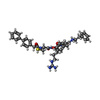[English] 日本語
 Yorodumi
Yorodumi- PDB-1mhw: Design of non-covalent inhibitors of human cathepsin L. From the ... -
+ Open data
Open data
- Basic information
Basic information
| Entry | Database: PDB / ID: 1mhw | ||||||
|---|---|---|---|---|---|---|---|
| Title | Design of non-covalent inhibitors of human cathepsin L. From the 96-residue proregion to optimized tripeptides | ||||||
 Components Components |
| ||||||
 Keywords Keywords | HYDROLASE/HYDROLASE INHIBITOR / CATHEPSIN L / CYSTEINE PROTEASE / HYDROLASE-HYDROLASE INHIBITOR COMPLEX | ||||||
| Function / homology |  Function and homology information Function and homology informationenkephalin processing / cathepsin L / CD4-positive, alpha-beta T cell lineage commitment / macrophage apoptotic process / chromaffin granule / elastin catabolic process / antigen processing and presentation of peptide antigen / RUNX1 regulates transcription of genes involved in differentiation of keratinocytes / endolysosome lumen / cellular response to thyroid hormone stimulus ...enkephalin processing / cathepsin L / CD4-positive, alpha-beta T cell lineage commitment / macrophage apoptotic process / chromaffin granule / elastin catabolic process / antigen processing and presentation of peptide antigen / RUNX1 regulates transcription of genes involved in differentiation of keratinocytes / endolysosome lumen / cellular response to thyroid hormone stimulus / Trafficking and processing of endosomal TLR / proteoglycan binding / zymogen activation / Assembly of collagen fibrils and other multimeric structures / antigen processing and presentation / protein autoprocessing / Collagen degradation / collagen catabolic process / fibronectin binding / serpin family protein binding / collagen binding / Attachment and Entry / Degradation of the extracellular matrix / receptor-mediated endocytosis of virus by host cell / multivesicular body / endocytic vesicle lumen / MHC class II antigen presentation / cysteine-type peptidase activity / lysosomal lumen / proteolysis involved in protein catabolic process / Endosomal/Vacuolar pathway / antigen processing and presentation of exogenous peptide antigen via MHC class II / : / histone binding / adaptive immune response / Attachment and Entry / lysosome / apical plasma membrane / fusion of virus membrane with host plasma membrane / cysteine-type endopeptidase activity / intracellular membrane-bounded organelle / fusion of virus membrane with host endosome membrane / symbiont entry into host cell / Golgi apparatus / proteolysis / extracellular space / extracellular exosome / extracellular region / nucleus / plasma membrane Similarity search - Function | ||||||
| Biological species |  Homo sapiens (human) Homo sapiens (human) | ||||||
| Method |  X-RAY DIFFRACTION / X-RAY DIFFRACTION /  MOLECULAR REPLACEMENT / Resolution: 1.9 Å MOLECULAR REPLACEMENT / Resolution: 1.9 Å | ||||||
 Authors Authors | Chowdhury, S. / Sivaraman, J. / Wang, J. / Devanathan, G. / Lachance, P. / Qi, H. / Menard, R. / Lefebvre, J. / Konishi, Y. / Cygler, M. ...Chowdhury, S. / Sivaraman, J. / Wang, J. / Devanathan, G. / Lachance, P. / Qi, H. / Menard, R. / Lefebvre, J. / Konishi, Y. / Cygler, M. / Sulea, T. / Purisima, E.O. | ||||||
 Citation Citation |  Journal: J.Med.Chem. / Year: 2002 Journal: J.Med.Chem. / Year: 2002Title: Design of non-covalent inhibitors of human cathepsin L. From the 96-residue proregion to optimized tripeptides Authors: Chowdhury, S. / Sivaraman, J. / Wang, J. / Devanathan, G. / Lachance, P. / Qi, H. / Menard, R. / Lefebvre, J. / Konishi, Y. / Cygler, M. / Sulea, T. / Purisima, E.O. | ||||||
| History |
|
- Structure visualization
Structure visualization
| Structure viewer | Molecule:  Molmil Molmil Jmol/JSmol Jmol/JSmol |
|---|
- Downloads & links
Downloads & links
- Download
Download
| PDBx/mmCIF format |  1mhw.cif.gz 1mhw.cif.gz | 113 KB | Display |  PDBx/mmCIF format PDBx/mmCIF format |
|---|---|---|---|---|
| PDB format |  pdb1mhw.ent.gz pdb1mhw.ent.gz | 85.6 KB | Display |  PDB format PDB format |
| PDBx/mmJSON format |  1mhw.json.gz 1mhw.json.gz | Tree view |  PDBx/mmJSON format PDBx/mmJSON format | |
| Others |  Other downloads Other downloads |
-Validation report
| Summary document |  1mhw_validation.pdf.gz 1mhw_validation.pdf.gz | 477.9 KB | Display |  wwPDB validaton report wwPDB validaton report |
|---|---|---|---|---|
| Full document |  1mhw_full_validation.pdf.gz 1mhw_full_validation.pdf.gz | 482 KB | Display | |
| Data in XML |  1mhw_validation.xml.gz 1mhw_validation.xml.gz | 28.3 KB | Display | |
| Data in CIF |  1mhw_validation.cif.gz 1mhw_validation.cif.gz | 39.4 KB | Display | |
| Arichive directory |  https://data.pdbj.org/pub/pdb/validation_reports/mh/1mhw https://data.pdbj.org/pub/pdb/validation_reports/mh/1mhw ftp://data.pdbj.org/pub/pdb/validation_reports/mh/1mhw ftp://data.pdbj.org/pub/pdb/validation_reports/mh/1mhw | HTTPS FTP |
-Related structure data
| Related structure data |  1cjlS S: Starting model for refinement |
|---|---|
| Similar structure data |
- Links
Links
- Assembly
Assembly
| Deposited unit | 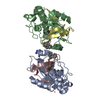
| ||||||||
|---|---|---|---|---|---|---|---|---|---|
| 1 | 
| ||||||||
| 2 | 
| ||||||||
| Unit cell |
|
- Components
Components
| #1: Protein | Mass: 19127.020 Da / Num. of mol.: 2 / Fragment: HEAVY CHAIN (residues 114-288) Source method: isolated from a genetically manipulated source Source: (gene. exp.)  Homo sapiens (human) / Production host: Homo sapiens (human) / Production host:  Pichia pastoris (fungus) / References: UniProt: P07711, cathepsin L Pichia pastoris (fungus) / References: UniProt: P07711, cathepsin L#2: Protein/peptide | Mass: 4783.409 Da / Num. of mol.: 2 / Fragment: LIGHT CHAIN (residues 292-333) Source method: isolated from a genetically manipulated source Source: (gene. exp.)  Homo sapiens (human) / Production host: Homo sapiens (human) / Production host:  Pichia pastoris (fungus) / References: UniProt: P07711, cathepsin L Pichia pastoris (fungus) / References: UniProt: P07711, cathepsin L#3: Protein/peptide | #4: Water | ChemComp-HOH / | Has protein modification | Y | |
|---|
-Experimental details
-Experiment
| Experiment | Method:  X-RAY DIFFRACTION / Number of used crystals: 1 X-RAY DIFFRACTION / Number of used crystals: 1 |
|---|
- Sample preparation
Sample preparation
| Crystal | Density Matthews: 2.25 Å3/Da / Density % sol: 45.44 % | ||||||||||||||||||||||||||||||||||||||||||
|---|---|---|---|---|---|---|---|---|---|---|---|---|---|---|---|---|---|---|---|---|---|---|---|---|---|---|---|---|---|---|---|---|---|---|---|---|---|---|---|---|---|---|---|
| Crystal grow | Temperature: 293 K / Method: vapor diffusion, hanging drop / pH: 4.2 Details: PEG 8K, Na Citrate, LiSo4, Isoproponal, pH 4.2, VAPOR DIFFUSION, HANGING DROP, temperature 293K | ||||||||||||||||||||||||||||||||||||||||||
| Crystal grow | *PLUS Temperature: 18 ℃ | ||||||||||||||||||||||||||||||||||||||||||
| Components of the solutions | *PLUS
|
-Data collection
| Diffraction | Mean temperature: 100 K |
|---|---|
| Diffraction source | Source:  ROTATING ANODE / Type: RIGAKU RU300 / Wavelength: 1.5418 Å ROTATING ANODE / Type: RIGAKU RU300 / Wavelength: 1.5418 Å |
| Detector | Type: RIGAKU RAXIS IIC / Detector: IMAGE PLATE / Date: Feb 10, 2002 |
| Radiation | Monochromator: Graphite / Protocol: SINGLE WAVELENGTH / Monochromatic (M) / Laue (L): M / Scattering type: x-ray |
| Radiation wavelength | Wavelength: 1.5418 Å / Relative weight: 1 |
| Reflection | Resolution: 1.9→50 Å / Num. all: 137661 / Num. obs: 134326 / % possible obs: 92.1 % / Observed criterion σ(F): 0 / Observed criterion σ(I): 0 / Redundancy: 4 % / Rsym value: 0.049 / Net I/σ(I): 18.9 |
| Reflection shell | Resolution: 1.9→1.97 Å / % possible all: 58 |
| Reflection | *PLUS Lowest resolution: 50 Å / Num. obs: 34166 / Num. measured all: 134326 / Rmerge(I) obs: 0.049 |
- Processing
Processing
| Software |
| |||||||||||||||||||||||||
|---|---|---|---|---|---|---|---|---|---|---|---|---|---|---|---|---|---|---|---|---|---|---|---|---|---|---|
| Refinement | Method to determine structure:  MOLECULAR REPLACEMENT MOLECULAR REPLACEMENTStarting model: pdb entry 1CJL Resolution: 1.9→45 Å / σ(F): 0 / Stereochemistry target values: Engh & Huber
| |||||||||||||||||||||||||
| Refine analyze | Luzzati coordinate error obs: 0.19 Å | |||||||||||||||||||||||||
| Refinement step | Cycle: LAST / Resolution: 1.9→45 Å
| |||||||||||||||||||||||||
| Refine LS restraints |
| |||||||||||||||||||||||||
| Xplor file |
| |||||||||||||||||||||||||
| Refinement | *PLUS Lowest resolution: 30 Å / Rfactor Rfree: 0.23 / Rfactor Rwork: 0.185 | |||||||||||||||||||||||||
| Solvent computation | *PLUS | |||||||||||||||||||||||||
| Displacement parameters | *PLUS | |||||||||||||||||||||||||
| Refine LS restraints | *PLUS
|
 Movie
Movie Controller
Controller


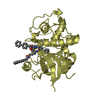

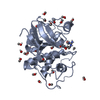

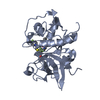

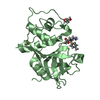
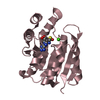


 PDBj
PDBj













